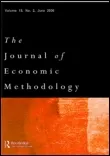- | Academic & Student Programs Academic & Student Programs
- | Journal Articles Journal Articles
- |
The Challenge of Empirically Assessing the Effects of Constitutions
Originally published in Journal of Economic Methodology
Mutually supporting methodologies are necessary for building a convincing case establishing a particular effect. Strengths and weaknesses of four empirical methods are discussed.

Mutually supporting methodologies are necessary for building a convincing case establishing a particular effect. Strengths and weaknesses of four empirical methods are discussed. Econometric methods quantify the relative importance of different factors and may assess the time frame over which constitutions matter, but have difficulties in dealing with nonlinear interactions among constitutional and cultural details. Cluster analysis can be a pre-requisite to other methods, and an analytic method in itself, useful for identifying the details that really matter and discovering surprising patterns in the data. I discuss the application of cluster analysis on the Comparative Constitutions Project database. Qualitative comparative analysis can reveal the hidden structure of interactions among different variables, but robustness checks are difficult to perform. Case studies are useful for distinguishing between rules-in-use and rules-in-form and for discovering important informal aspects. They can deal with complex nonlinearities well, but they are often hard to generalize.
Find article at Taylor & Francis.
To speak with a scholar or learn more on this topic, visit our contact page.

